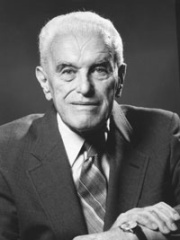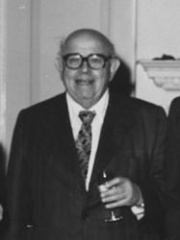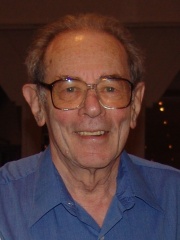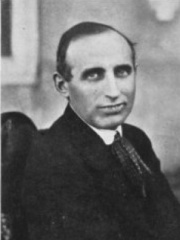



The Most Famous
ECONOMISTS from Hungary
This page contains a list of the greatest Hungarian Economists. The pantheon dataset contains 414 Economists, 4 of which were born in Hungary. This makes Hungary the birth place of the 17th most number of Economists behind Belgium, and Norway.
Top 5
The following people are considered by Pantheon to be the most legendary Hungarian Economists of all time. This list of famous Hungarian Economists is sorted by HPI (Historical Popularity Index), a metric that aggregates information on a biography’s online popularity.

1. John Harsanyi (1920 - 2000)
With an HPI of 58.73, John Harsanyi is the most famous Hungarian Economist. His biography has been translated into 46 different languages on wikipedia.
John Charles Harsanyi (Hungarian: Harsányi János Károly; May 29, 1920 – August 9, 2000) was a Hungarian-American economist who spent most of his career at the University of California, Berkeley. He was the recipient of the Nobel Memorial Prize in Economic Sciences in 1994. Harsanyi is best known for his contributions to the study of game theory and its application to economics, specifically for his developing the highly innovative analysis of games of incomplete information, so-called Bayesian games. He also made important contributions to the use of game theory and economic reasoning in political and moral philosophy (specifically utilitarian ethics) as well as contributing to the study of equilibrium selection. For his work, he was a co-recipient along with John Nash and Reinhard Selten of the 1994 Nobel Memorial Prize in Economic Sciences. He moved to the United States in 1956, and spent most of his life there. According to György Marx, he was one of The Martians.

2. Nicholas Kaldor (1908 - 1986)
With an HPI of 55.61, Nicholas Kaldor is the 2nd most famous Hungarian Economist. His biography has been translated into 29 different languages.
Nicholas Kaldor, Baron Kaldor (12 May 1908 – 30 September 1986), born Káldor Miklós, was a Hungarian economist. He developed the "compensation" criteria called Kaldor–Hicks efficiency for welfare comparisons (1939), derived the cobweb model, and argued for certain regularities observable in economic growth, which are called Kaldor's growth laws. Kaldor worked alongside Gunnar Myrdal to develop the key concept Circular Cumulative Causation, a multicausal approach where the core variables and their linkages are delineated.

3. János Kornai (1928 - 2021)
With an HPI of 54.58, János Kornai is the 3rd most famous Hungarian Economist. His biography has been translated into 20 different languages.
János Kornai (21 January 1928 – 18 October 2021) was a Hungarian economist noted for his analysis and criticism of the command economies of Eastern European communist states. He also covered macroeconomic aspects in countries undergoing post-Soviet transition. He was emeritus professor at both Harvard University and Corvinus University of Budapest. Kornai was known to have coined the term shortage economy to reflect perpetual shortages of goods in the centrally-planned command economies of the Eastern Bloc.

4. Eugen Varga (1879 - 1964)
With an HPI of 50.70, Eugen Varga is the 4th most famous Hungarian Economist. His biography has been translated into 17 different languages.
Eugen Samuilovich "Jenő" Varga (born as Eugen Weisz, November 6, 1879 – October 7, 1964) was a Soviet economist of Hungarian origin.

5. László Andor (b. 1966)
With an HPI of 36.28, László Andor is the 5th most famous Hungarian Economist. His biography has been translated into 16 different languages.
László Andor (born 3 June 1966 in Zalaegerszeg) is a Hungarian economist and the Secretary General of the Foundation for European Progressive Studies (FEPS). From 2010 to 2014 he was Commissioner for Employment, Social Affairs and Inclusion in the Barroso II administration of the European Commission. From 2005 to 2010 he was a Member of the Board of Directors of the European Bank for Reconstruction and Development (EBRD), representing the Czech Republic, Croatia, Hungary and Slovakia. He studied Economics at the Corvinus University of Budapest (then called the Karl Marx University), and later became Associate Professor of Economic Policy at the same institution. He also studied at the George Washington University in Washington, D.C., and in 1993 earned a master's degree in Development Economics at the University of Manchester. Since 1993, he has been editor of a progressive (leftist) Hungarian quarterly social science journal, Eszmélet (Consciousness). Since 2003, he has been a member of the board of the Economic Section of the Hungarian Socialist Party. He was once appointed Acting Commissioner for Consumer Protection in Neven Mimica's stead, from 19 April 2014 – 25 May 2014 while he was on electoral campaign leave for the 2014 elections to the European Parliament. He ultimately decided to not take up his seat. László Andor is a member of the member of the advisory board of the Prague European Summit.
People
Pantheon has 5 people classified as Hungarian economists born between 1879 and 1966. Of these 5, 1 (20.00%) of them are still alive today. The most famous living Hungarian economists include László Andor. The most famous deceased Hungarian economists include John Harsanyi, Nicholas Kaldor, and János Kornai. As of April 2024, 1 new Hungarian economists have been added to Pantheon including László Andor.
Living Hungarian Economists
Go to all RankingsDeceased Hungarian Economists
Go to all RankingsJohn Harsanyi
1920 - 2000
HPI: 58.73
Nicholas Kaldor
1908 - 1986
HPI: 55.61
János Kornai
1928 - 2021
HPI: 54.58
Eugen Varga
1879 - 1964
HPI: 50.70
Newly Added Hungarian Economists (2024)
Go to all RankingsOverlapping Lives
Which Economists were alive at the same time? This visualization shows the lifespans of the 4 most globally memorable Economists since 1700.

